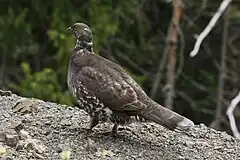| Dendragapus[1] | |||
| Elliot, 1864[2] | |||
 Przedstawiciel rodzaju – borowiak żółtogardły (D. fuliginosus) | |||
| Systematyka | |||
| Domena | |||
|---|---|---|---|
| Królestwo | |||
| Typ | |||
| Podtyp | |||
| Gromada | |||
| Podgromada | |||
| Infragromada | |||
| Rząd | |||
| Rodzina | |||
| Podrodzina | |||
| Plemię | |||
| Rodzaj |
Dendragapus | ||
| Typ nomenklatoryczny | |||
|
Tetrao obscurus Say, 1822 | |||
| Synonimy | |||
|
| |||
| Gatunki | |||
| |||
Dendragapus – rodzaj ptaków z podrodziny bażantów (Phasianinae) w rodzinie kurowatych (Phasianidae).
Zasięg występowania
Rodzaj obejmuje gatunki występujące w Ameryce Północnej[5].
Morfologia
Długość ciała samców 47–57 cm, samic 44–48 cm; masa ciała samców 1117–1245 g, samic 829–890 g[6].
Systematyka
Etymologia
Podział systematyczny
Do rodzaju należą następujące gatunki[9]:
Przypisy
- ↑ Dendragapus, [w:] Integrated Taxonomic Information System (ang.).
- ↑ D.G. Elliot. Remarks upon a Proposed Arrangement of the Family of Grouse, and New Genera Added. „Proceedings of the Academy of Natural Sciences of Philadelphia”. 16, s. 23, 1864. (ang.).
- ↑ Ch.G. Giebel: Thesaurus ornithologiae: Repertorium der gesammten ornithologischen Literatur und Nomenclator sämmtlicher Gattungen und Arten der Vögel, nebst Synonymen und geographischer Verbreitung. Cz. 2. Leipzig: Brockhaus, 1875, s. 33. (niem.).
- ↑ R.W. Shufeldt. A study of the fossil avifauna of the Equus Beds of the Oregon desert. „Journal of the Academy of Natural Sciences of Philadelphia”. Second Series. 9, s. 415, 1892. (ang.).
- ↑ F. Gill, D. Donsker & P. Rasmussen (red.): IOC World Bird List (v11.2). [dostęp 2021-07-21]. (ang.).
- ↑ E. de Juana: Family Tetraonidae (Grouse). W: J. del Hoyo, A. Elliott & J. Sargatal: Handbook of the Birds of the World. Cz. 2: New World Vultures to Guineafowl. Barcelona: Lynx Edicions, 1994, s. 401. ISBN 84-87334-15-6. (ang.).
- ↑ Jobling 2021 ↓, s. Dendragapus.
- ↑ Jobling 2021 ↓, s. Palaeotetrix.
- ↑ Systematyka i nazwy polskie za: P. Mielczarek & M. Kuziemko: Plemię: Tetraonini Leach, 1820 (wersja: 2021-04-05). [w:] Kompletna lista ptaków świata [on-line]. Instytut Nauk o Środowisku Uniwersytetu Jagiellońskiego. [dostęp 2021-07-21].
- ↑ S.V. Drovetski. Molecular phylogeny of grouse: Individual and Combined Performance of W-Linked, Autosomal, and Mitochondrial loci. „Systematic Biology”. 51 (6), s. 930–945, 2002. DOI: 10.1080/10635150290102500. (ang.).
- ↑ G.F. Barrowclough, J.G. Groth, L.A. Mertz & R.J. Gutiérrez. Phylogeographic structure, gene flow and species status in blue grouse (Dendragapus obscurus). „Molecular Ecology”. 13, s. 1911–1922, 2004. (ang.).
Bibliografia
- James A. Jobling: The Key to Scientific Names. [w:] Birds of the World [on-line]. Cornell Laboratory of Ornithology, Ithaca, NY, USA, 2021. (ang.).
Identyfikatory zewnętrzne (takson monotypowy):
This article is issued from Wikipedia. The text is licensed under Creative Commons - Attribution - Sharealike. Additional terms may apply for the media files.